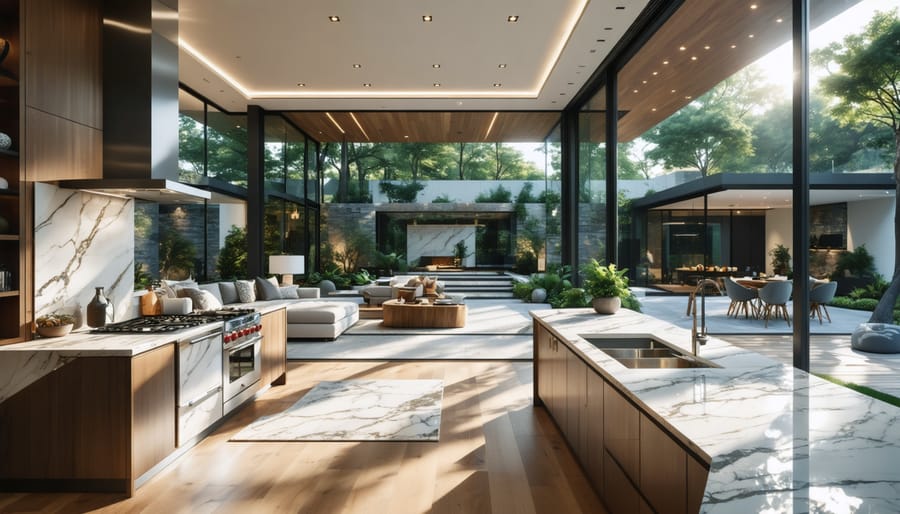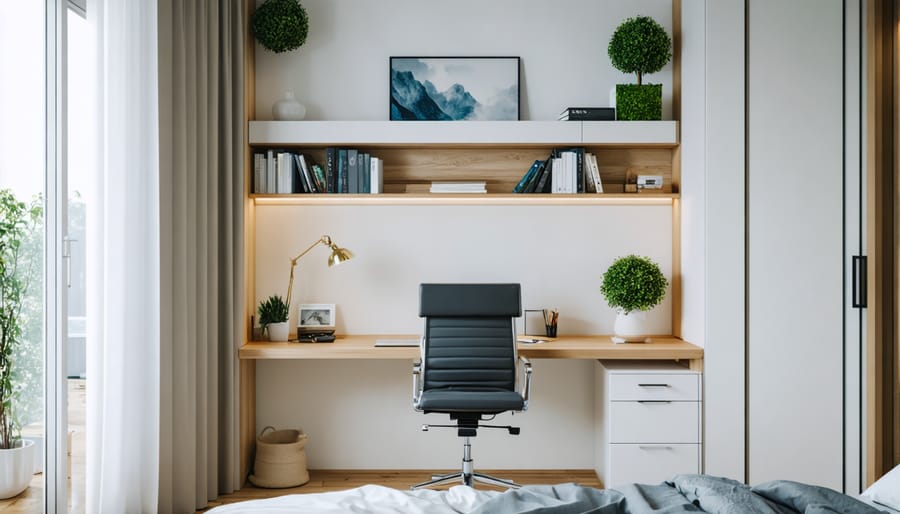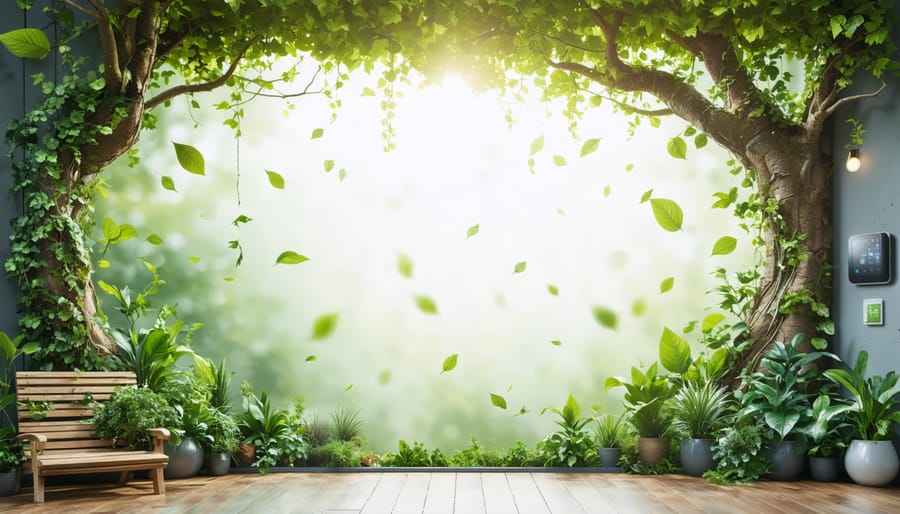Embrace energy efficiency by installing LED lighting and investing in energy-efficient appliances to reduce your carbon footprint and lower utility bills. Incorporate natural materials by choosing sustainable resources like bamboo or reclaimed wood for furniture and flooring to enhance indoor air quality and aesthetics. Implement water-saving techniques such as low-flow faucets and dual-flush toilets, significantly reducing water consumption without sacrificing performance. Integrate smart technology with programmable thermostats and smart home systems to optimize energy usage effortlessly. Consider using eco-friendly paints and finishes that emit fewer volatile organic compounds to create a healthier living environment. For further guidance on transforming your space, explore our comprehensive guide to eco-friendly living.
Key Features of a Sustainable Home

Energy Efficiency
Creating a sustainable home begins with optimizing energy efficiency. By incorporating energy-saving measures, you can significantly reduce your carbon footprint and utility bills. Start by switching to LED bulbs, which use up to 75% less energy than traditional lighting. Consider installing a programmable thermostat to precisely control heating and cooling systems according to your schedule. Sealing gaps around doors and windows can prevent drafts, keeping your home cozy without overuse of heating. If you’re feeling adventurous, you might explore solar panels as a renewable energy source. These enhancements are not only eco-friendly but can also enhance your home’s value.
Water Conservation
In a sustainable home, water conservation is key. Simple upgrades like low-flow showerheads and faucet aerators can drastically reduce water usage without sacrificing comfort. These fixtures are not only easy to install but can also be an exciting DIY project for those eager to make a difference. Another innovative method is rainwater harvesting, which captures and reuses rainwater for gardening or non-potable household tasks. By implementing a rain barrel system, you not only save water but also benefit from lower utility bills. Embracing these water-saving features contributes to a more eco-friendly home, aligning your living space with sustainable practices.
Use of Sustainable Materials
Choosing the right materials for your home is a key component of sustainability. Opt for materials that are both durable and kind to the environment. Consider using bamboo, a rapidly renewable resource, known for its strength and versatility. Recycled metal is another excellent option, offering the durability of traditional metals without depleting natural resources. Salvaged wood adds character and warmth while minimizing deforestation. For insulation, look into sheep’s wool or recycled denim—natural solutions that provide excellent thermal properties. By selecting materials with a low environmental impact, you not only create a healthier home but also contribute positively to the planet.
Benefits of Living in a Sustainable Home
Environmental Impact
Sustainable homes play a significant role in reducing our environmental footprint by optimizing resources and energy efficiency. These homes use eco-friendly materials, employ renewable energy sources like solar power, and prioritize water conservation. Simple steps, such as installing energy-efficient appliances and using natural insulation, can significantly lower carbon emissions. By incorporating smart design elements, sustainable homes improve air quality and create healthier living spaces. They also encourage the use of locally sourced and sustainable materials, reducing transportation impacts. Each improvement, no matter how small, contributes to a collective effort toward a more sustainable future, making it easier for you to start implementing these strategies today.
Financial Savings
Choosing a sustainable home is not just good for the planet; it’s also beneficial for your wallet. Over time, energy-efficient solutions and sustainable practices lead to significant savings on utility bills. For instance, by incorporating energy-efficient appliances and smart home systems, you can reduce energy usage, showcasing immediate and long-term cost savings. Additionally, sustainable homes often benefit from lower maintenance costs due to the quality of materials used, which are designed to be durable and long-lasting. By investing in sustainability now, you can enjoy financial savings for years to come, making your home a wise and eco-friendly financial decision.
DIY Tips for Creating a Sustainable Home
Simple Energy Solutions
Switching to simple energy solutions can seamlessly fit into any home improvement plan, bringing both sustainability and savings. Start with the basics like replacing traditional incandescent bulbs with LED ones. LEDs use significantly less energy, last longer, and provide the same cozy glow we all love. You can also explore weather-stripping your windows and doors to seal in warmth during the chilly months, reducing the need for constant heating. Look for energy-efficient appliances with an Energy Star rating when replacing old models; these are designed to consume less power without compromising on performance. For the DIY enthusiast, consider installing a programmable thermostat, which lets you set a schedule for heating and cooling, adapting to your home’s rhythm while cutting down on wasted energy. Understanding your energy usage is key, so take advantage of smart meters to track and optimize your consumption. These small steps not only reduce bills but also lay the foundation for a more sustainable living space.

Water-Saving Hacks
Saving water can be both simple and rewarding with a few DIY projects that make a big impact. Consider setting up a rain barrel to collect rainwater from your roof; this natural reservoir can be used for watering plants and gardens, reducing your utility bill and conserving water. You might also try installing low-flow showerheads and faucet aerators, which can curb water usage without sacrificing performance. Get creative by placing a bucket in your shower to catch excess water while it warms up—perfect for watering plants later. These small changes are a step toward a sustainable home that respects the planet.
Repurposing and Recycling
Transforming your home into a sustainable haven can be both rewarding and fun, especially when repurposing materials for home improvement. Start with creative DIY projects like turning old wooden crates into charming bookshelves or using reclaimed wood to craft unique wall art. These not only reduce waste but add a warm, personal touch to your space. Consider repurposing glass jars for stylish storage solutions or retrofitting vintage furniture for a fresh look. For more inspiration, explore earth-friendly decor ideas that beautifully blend sustainability with style. Embrace these small, yet impactful, changes to make your home greener.
Expert Tips for Designing a Sustainable Home
Integrated Design Approaches
When designing a sustainable home, it’s all about looking at the bigger picture. Think of your home as a living ecosystem where every element plays a critical role. Start with energy efficiency—using solar panels or energy-star appliances can significantly cut down on energy bills and reduce your carbon footprint. Next, consider the materials you choose. Opt for locally sourced, environmentally friendly options like bamboo flooring, recycled steel, or reclaimed wood. These not only look fantastic but are kind to the planet. Water conservation is another key aspect. Installing low-flow fixtures or rainwater harvesting systems can make a huge difference. Don’t overlook indoor air quality, either—integrate plants that purify the air naturally and use paints free of volatile organic compounds (VOCs). Finally, how about some DIY inspiration? Create a vertical garden or build your own composting system to enrich your garden naturally. Each step contributes to a healthier, more sustainable living space, making a positive impact not just on your life, but the environment too.
Working with Professionals
Collaborating with ecological architects and designers offers invaluable benefits for creating a sustainable home. These professionals bring a wealth of knowledge in sustainable building practices, ensuring your home not only meets but exceeds environmental standards. By working with them, you can access innovative ideas that you might not have considered, such as integrating passive solar design or using reclaimed materials in creative ways. They can also help navigate local building codes efficiently, saving you time and potential headaches. With their guidance, you can make informed decisions that align with your budget and sustainability goals, transforming your living space into an eco-friendly haven.
Conclusion
Creating a sustainable home matters more than ever, offering benefits beyond just environmental impact—it enhances comfort, reduces costs, and boosts your home’s value. As you embark on this journey, it’s important to remember that every small change counts. Start by assessing your lifestyle and home energy needs, then implement simple changes, like swapping to energy-efficient bulbs or investing in smart thermostats. For the DIY enthusiasts, explore creative options like building DIY rainwater collection systems or setting up a small herb garden that make sustainability both practical and rewarding. Embrace these steps at your own pace, and remember, the move toward a sustainable home doesn’t have to be daunting. Every improvement you make contributes to a healthier lifestyle and a better planet. Let your home reflect the values you cherish, and enjoy the satisfying journey of crafting a space that’s harmonious with nature and tailored to your unique needs.





